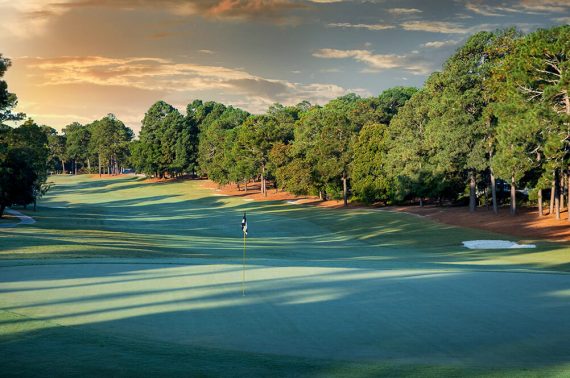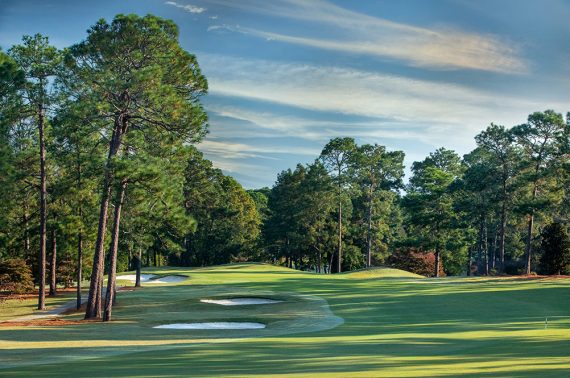Pinehurst Resort’s Director of Golf Ben Bridgers and longtime Vice President of Course Maintenance Bob Farren sat down with us to talk about Course No. 5, a classic Ellis Maples design that’s a favorite among our members – and our guests as well, once they experience it.
Ben Bridgers: Out of our classic core courses, also including No. 1 and No. 3, No. 5 is the most challenging tee to green. With some out of bounds prevalent, you have to drive the ball straight, as there’s more OB here than any of our other layouts. There are some good birdie opportunities, but from the tips No. 5 has some serious teeth.
Bob Farren: Pinehurst No.5 is appealing to our members and resort guests alike because it brings balance to the rotation. Originating from the main clubhouse and requiring just a short ride or walk across Beulah Hill road, it plays longer than No. 1 and No. 3 but isn’t as demanding as No. 2 or No. 4.
Bridgers: You can certainly see shades of Donald Ross with the elevation changes and varying doglegs. Even though Ross didn’t design it there are some of his old holes (from the original No. 3, designed in 1911) within the routing.
Farren: Ellis Maples, the architect of No. 5, was the son of Frank Maples, who was the longtime Pinehurst Head Greenkeeper and construction superintendent for Donald Ross. Designed in 1961, No. 5 incorporated five holes of the Ross’s original design of No. 3. For those interested in golf course architecture it is intriguing to visualize how the Ellis Maples holes overlay Ross’s. The greens on No. 5 are much less undulating and in sharp contrast to the elevated, severe greens on No. 2 and No. 3.

Pinehurst No. 5, 16th hole
Bridgers: Holes 13-15 make for a tremendous stretch featuring a long uphill par-5 (No. 13), a great downhill par-3 in 14 (the famed Cathedral Hole), and a dogleg right, par-4 with a challenging uphill green.
Farren: I love 9-through-13 due to the challenge and scenery. No. 9 (a par-4) is a sharp dogleg right downhill to a green with Lake Pinehurst in the background. It’s followed by the next three holes where water can come into play.
Bridgers: The second hole is a relatively short par-5, and a close second would be the third hole, a short par-4 that fits my eye and only requires a wedge into the green.
Farren: The short par-4 seventh hole presents a good opportunity followed by a demanding eighth hole with a challenging elevated green, presenting a nice sequence of two holes.
Bridgers: No. 9 is a serious challenge as you have to cut your drive around the trees to have a short-iron in, or you can lay back with something less than driver for an approach shot to a downhill green. My recommendation would be to take a long-iron or hybrid off the tee. You can easily drive it out of bounds on the right or blow it straight through the fairway.
Farren: The par-4 15th plays just 370 yards from the white tees and can sneak up on you if you allow your tee shot to go through the fairway into the hazard on the left side. For what appears might be an easy par or reasonable birdie opportunity, this sporty two-shotter can prove to be otherwise.

Pinehurst No. 5, 7th Hole
Bridgers: No. 5 has some great character to it, whether it be the stretch of holes around Lake Pinehurst or some of its more challenging holes. The layout has plenty of length for longer players but also has some great chances for birdies. No. 5 is yet another connection to our Donald Ross and Maples family roots here at Pinehurst Resort.
Farren: You can enjoy a nice relaxing round with ample birdie opportunities, nice rolling terrain, water on four holes but no forced carries and wide variety of tees and lengths to select from.

